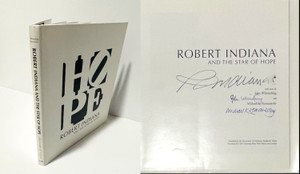
Hermann Zapf, J. Robert Oppenheimer poster with quote about the role of the Artist vs. Scientist, hand signed by world renowned designer Hermann Zapf, 1974
Hermann ZapfHermann Zapf
J. Robert Oppenheimer poster with quote about the role of the Artist vs. Scientist, hand signed by world renowned designer Hermann Zapf, 1974
Offset lithograph and lithograph on cream colored paper
Pencil signed and inscribed to Paul A. Wagner
Unnumbered
28 × 18 1/2 inches
Unframed
Artist hand signed and inscribed lithographic poster signed with a famous quotation by J. Robert Oppenheimer. Color printed broadside with text in German and English featuring a quote from Oppenheimer’s Prospects in the Arts and Sciences, 1955, signed by Zapf in pencil and with an additional inscription to Paul A. Wagner. The Oppenheim quote reads as follows:
From: J. R OPPENHEIMER: "PROSPECTS IN THE ARTS AND SCIENCES"":
"In the situation of the artist today there are both analogies to and differences from that of the scientist; but it is the differences which are the most striking, and which raise the problems that touch most on the evil of our day. For the artist it is not enough that he communicate with others who are expert in his own art. Their fellowship, their understanding, and their appreciation may encourage him; but that is not the end of his work, nor its nature. The artist depends on a common sensibility and culture, on a common meaning of symbols, on a community of experience and common ways of describing and interpreting it. He need not write for everyone or paint or play for everyone. But his audience must be man; it must be man, and not a specialized set of experts among his fellows. Today that is very difficult. Often the artist has an aching sense of great loneliness, for the community to which he addresses himself is largely not there; the traditions and the culture, the symbols and the history, the myths and the common experience, which it is his function to illuminate, to harmonize, and to portray, have been dissolved in a changing world."
An uncommon signed broadside poster offering this quote from the theoretical physicist and director of the Manhattan Project, J. Robert Oppenheimer. The eponymous Hollywood feature film based on Oppenheimer’s life and career was awarded the Best Picture Oscar for 2023.
Makes a brilliant gift for anybody who happened to be involved in the Oppenheimer movie -- or for any fan of the biography and movie - or for fans and followers of the legendary Hermann Zapf.
Excerpt from 2015 New York Times obituary entitled,
Hermann Zapf, 96, Dies; Designer Whose Letters Are Found Everywhere
Hermann Zapf, whose calling in life — “to create beautiful letters,” as one of his students put it — found expression in lush, steady-handed calligraphy and in subtly inventive typefaces that have brought words to readers on paper, on signposts, on monuments and on computer screens for more than half a century, died on Thursday at his home in Darmstadt, Germany. He was 96.
Jerry Kelly, a leading American typographer, calligrapher and type designer who was a friend and former student of Mr. Zapf, confirmed the death.
In the world of type design — an exacting, arcane craft that is underappreciated for its impact on how people communicate and receive communication — Mr. Zapf (pronounced DZAHFF) was a giant. Prolific and versatile, he created around 200 typefaces in numerous alphabets, including Latin, Cyrillic, Arabic and Cherokee, spanning the eras of metal typesetting, phototypesetting and digital typesetting. His typefaces include:
¶ Palatino, his breakthrough font, a much-copied classical Roman design adapted for the 20th century. It is available on Microsoft Word and from Linotype and other sources and is being used by Abercrombie & Fitch for its corporate logo.
¶ Optima, a revolutionary font that melded the thick and thin strokes of a traditional typeface within a sans serif design. Its capital letters are used for the names inscribed on the Maya Lin-designed Vietnam Veterans Memorial in Washington, and its bold version was used for John McCain’s presidential campaign posters and buttons and continues to be used by the Estée Lauder cosmetics company on its packaging.
¶ Melior, a serif type designed for newspapers including The Village Voice, which used it for years.
¶ Hunt Roman, a sturdy serif designed for use by a botanical library.
¶ Zapfino, a sweeping calligraphic font that ships with every Macintosh computer.
¶ Melior, a serif type designed for newspapers including The Village Voice, which used it for years.
¶ Hunt Roman, a sturdy serif designed for use by a botanical library.
¶ Zapfino, a sweeping calligraphic font that ships with every Macintosh computer.
¶ Zapf Dingbats, a collection of symbols that achieved wide popularity when it was built into an Apple laser printer in the 1980s.
It may be difficult to explain the type designer’s art to the unschooled, but in interviews other type designers had no trouble assessing Mr. Zapf’s stature.
“Last Thursday, all the rest of us moved up one,” said Matthew Carter, whose designs for web fonts, including Verdana and Georgia, earned a MacArthur Fellowship, the so-called genius award, in 2010. “That’s my way of saying Hermann was on top.”
Mr. Kelly said: “What Michelangelo was to sculpture and Beethoven was to music, that’s what Hermann Zapf is to type design and calligraphy. We’re all followers of his now.”











